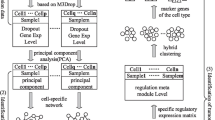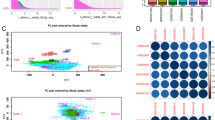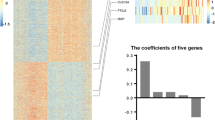Abstract
Glioma is the most common primary brain tumor in humans and the most deadly. Stem cells, which are characterized by therapeutic resistance and self-renewal, play a critical role in glioma, and therefore the identification of stem cell-related genes in glioma is important. In this study, we collected and evaluated the epigenetically regulated-mRNA expression-based stemness index (EREG-mRNAsi) of The Cancer Genome Atlas (TCGA, http://www.ncbi.nlm.nih.gov/) for glioma patient samples, corrected through tumor purity. After EREG-mRNAsi correction, glioma pathological grade and survival were analyzed. The differentially expressed gene (DEG) co-expression network was constructed by weighted gene co-expression network analysis (WGCNA) in TCGA glioma samples to find modules of interest and key genes. Gene ontology (GO) and pathway-enrichment analysis were performed to identify the function of significant genetic modules. Protein–protein interaction (PPI) and co-expression network analysis of key genes was performed for further analysis. In this experiment, we found that corrected EREG-mRNAsi was significantly up-regulated in glioma samples and increased with glioma grade, with G4 having the highest stemness index. Patients with higher corrected EREG-mRNAsi scores had worse overall survival. Fifty-one DEGs in the brown gene module were found to be positively related to EREG-mRNAsi via WGCNA. GO and Kyoto Encyclopedia of Genes and Genomes (KEGG) enrichment analysis showed that chromosome segregation and cell cycle molecular function were the major functions in key DEGs. Among these key DEGs, BUB1 showed high connectivity and co-expression, and also high connectivity in PPI. Fifty-one key genes were verified to play a critical role in glioma stem cells. These genes may serve as primary therapeutic targets to inhibit the activity of glioma stem cells.






Similar content being viewed by others
References
Aldape KD et al (2003) Molecular epidemiology of glioblastoma. Cancer J 9(2):99–106
Aran D, Sirota M, Butte AJ (2015) Systematic pan-cancer analysis of tumour purity. Nat Commun 6:8971
Ben-Porath I et al (2008) An embryonic stem cell-like gene expression signature in poorly differentiated aggressive human tumors. Nat Genet 40(5):499–507
Bexell D, Svensson A, Bengzon J (2013) Stem cell-based therapy for malignant glioma. Cancer Treat Rev 39(4):358–365
Delgado-Lopez PD, Corrales-Garcia EM (2016) Survival in glioblastoma: a review on the impact of treatment modalities. Clin Transl Oncol 18(11):1062–1071
Eppert K et al (2011) Stem cell gene expression programs influence clinical outcome in human leukemia. Nat Med 17(9):1086–1093
Hattermann K et al (2016) Stem cell markers in glioma progression and recurrence. Int J Oncol 49(5):1899–1910
Jain KK (2018) A critical overview of targeted therapies for Glioblastoma. Front Oncol 8:419
Kang J et al (2008) Structure and substrate recruitment of the human spindle checkpoint kinase Bub1. Mol Cell 32(3):394–405
Kim J et al (2010) A Myc network accounts for similarities between embryonic stem and cancer cell transcription programs. Cell 143(2):313–324
Kiyomitsu T, Obuse C, Yanagida M (2007) Human Blinkin/AF15q14 is required for chromosome alignment and the mitotic checkpoint through direct interaction with Bub1 and BubR1. Dev Cell 13(5):663–676
Langfelder P, Horvath S (2008) WGCNA: an R package for weighted correlation network analysis. BMC Bioinformatics 9:559
Li L et al (2013) Combination analysis of Bub1 and Mad2 expression in endometrial cancer: act as a prognostic factor in endometrial cancer. Arch Gynecol Obstet 288(1):155–165
Malta TM et al (2018) Machine Learning Identifies Stemness Features Associated with Oncogenic Dedifferentiation. Cell 173(2):338–354.e15
Morales AG et al (2013) BUB1 and BUBR1 inhibition decreases proliferation and colony formation, and enhances radiation sensitivity in pediatric glioblastoma cells. Childs Nerv Syst 29(12):2241–2248
Spencer DA et al (2017) Hitting a moving target: Glioma stem cells demand new approaches in Glioblastoma therapy. Curr Cancer Drug Targets 17(3):236–254
Stupp R et al (2005) Radiotherapy plus concomitant and adjuvant temozolomide for glioblastoma. N Engl J Med 352(10):987–996
Xu B et al (2017) MiR-490-5p suppresses cell proliferation and invasion by targeting BUB1 in hepatocellular carcinoma cells. Pharmacology 100(5-6):269–282
Yip AM, Horvath S (2007) Gene network interconnectedness and the generalized topological overlap measure. BMC Bioinformatics 8:22
Yu H et al (2019) Serine/threonine kinase BUB1 promotes proliferation and radio-resistance in glioblastoma. Pathol Res Pract 215(8):152508
Acknowledgements
The authors thank the contributors of TCGA for sharing the glioma data.
Author information
Authors and Affiliations
Contributions
This study was designed by Pengfei Xia. The data were extracted by Pengfei Xia, Yimin Huang and Qing Li. Yimin Huang and Guanlin Wu performed statistical analysis. The manuscript was written by Pengfei Xia and Guanlin Wu. This manuscript was originally written, and the final manuscript was approved by all the authors.
Corresponding author
Ethics declarations
Conflict of Interest
All authors have read and approved the submission of this work according to journal guidelines. There are no conflicts of interest of any authors in relation to the submission.
Additional information
Publisher’s Note
Springer Nature remains neutral with regard to jurisdictional claims in published maps and institutional affiliations.
Rights and permissions
About this article
Cite this article
Xia, P., Li, Q., Wu, G. et al. Identification of Glioma Cancer Stem Cell Characteristics Based on Weighted Gene Prognosis Module Co-Expression Network Analysis of Transcriptome Data Stemness Indices. J Mol Neurosci 70, 1512–1520 (2020). https://doi.org/10.1007/s12031-020-01590-z
Received:
Accepted:
Published:
Issue Date:
DOI: https://doi.org/10.1007/s12031-020-01590-z




